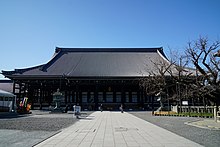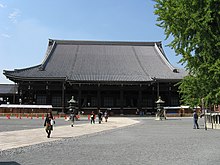Nishi Hongan-ji
| Nishi Hongan-ji Tây bổn nguyện tự | |
|---|---|
 Amidadō and Goeidō (National Treasures) | |
| Religion | |
| Affiliation | Jōdo ShinshūHonganji-ha |
| Deity | Amida Nyorai(Amitābha) |
| Status | Head temple |
| Location | |
| Location | 60 Monzen-machi, Horikawa-dōri Hanaya-chō Kudaru,Shimogyō-ku,Kyoto,Kyoto Prefecture |
| Country | Japan |
| Geographic coordinates | 34°59′31.37″N135°45′5.8″E/ 34.9920472°N 135.751611°E |
| Architecture | |
| Founder | Honganji Kennyo |
| Completed | 1591 |
| Website | |
| http://www.hongwanji.or.jp/english/ | |
Nishi Hongan-ji(Tây bổn nguyện tự)is aJōdo ShinshūBuddhisttemple in theShimogyōward ofKyoto,Japan.It serves as the head temple of the sub-sectHonganji-ha.
It is one of twoJōdo Shinshūtemple complexes in Kyoto, the other beingHigashi Hongan-ji,which is the head temple of the sub-sectŌtani-ha.
Established in its current location in 1591, the origin of the temple goes back to the 14th century. Many of its building have survived from theAzuchi-Momoyamaand earlyEdo period,making it a great example of the Japanese architecture from the 17th and 18th centuries. A total of seven Nishi Hongan-ji structures have been designatedNational Treasuresin three different categories: thekaramon,Goei-dō andAmidahall (temple buildings), the Flying Cloud Pavilion,shoinand the Black study hall, including the Denrō gallery (residences) and the northNohstage (miscellaneous structure).
Nishi Hongan-ji was designated aUNESCOWorld Heritage Sitein 1994, as part of theHistoric Monuments of Ancient Kyoto.
History[edit]
The originalHongan-jiwas established as a temple in 1321, on the site of the Ōtani Mausoleum, whereShinran,the founder of theJōdo Shinshū( "True Pure Land" ) was buried. The mausoleum was attended by Shinran's grandson (through daughter Kakushinni), Kakue.[1]Kakue's own son,Kakunyo,became the first chief priest of the Hongan-ji and thirdmonshu(spiritual leader), and dedicated it to the worship ofAmitābha(Amida). The Hongan-ji first gained power and importance in the 15th century, whenRennyobecame its eighth monshu. However, theTendaibased onMount Hieisaw this expansion as a threat and attacked the Hongan-ji three times with their army ofsōhei.Rennyofled toYoshizaki-gobō,where he established a new temple compound.
During theSengoku period,fearing the power of the monks of the Hongan-ji,Oda Nobunagatried to destroy it. For ten years, he laid siege to theIshiyama Hongan-jiinOsaka,one of the two primary temple fortresses of the sect. In 1580, the abbot of the Ishiyama Hongan-ji, Kennyo, surrendered, while his son Kyōnyo refused to surrender, for which he was publicly disowned.[2]
After the death of Nobunaga in 1582 and the ascent ofToyotomi Hideyoshi,Kennyo was rewarded for his opposition to Nobunaga by being granted land in Kyoto, at the site of modern-day Nishi Hongan-ji ( tây bổn nguyện tự, "Western Hongan-ji"; sometimes called theHonpa Hongan-jiBổn phái bổn nguyện tự ). He was succeeded by his legitimate son, Junnyo, as abbot in 1592. While his brother Kyōnyo re-established the Osaka Hongan-ji in 1596 with local support, owing to his refusal to surrender to Nobunaga earlier. After the death of Hideyoshi in 1598, Kyōnyo openly supportedTokugawa Ieyasu,who becameshōgunin 1602. In reward for his loyalty, Kyōnyo was rewarded with land for a temple in Kyoto to the east of Nishi Honganji, which then became known in 1603 asHigashi Honganji( đông bổn nguyện tự "Eastern Hongan-ji" ). In 1619 the government recognized the two entities as separate congregations. It is popularly believed, however mistakenly, that the institution was split in two in order to maintain control of the order.[3][4]
In 1994 Nishi Hongan-ji was listed as aUNESCO World Heritage Siteas one of theHistoric Monuments of Ancient Kyoto.
Architecture[edit]
Nishi Hongan-ji occupies almost an entire rectangular area bounded byHanayachō-dōri(Hanayachō Street) to the north,Horikawa-dōri(Horikawa Street) to the east,AShichijō-dōri(Shichijō Street) to the south, andŌmiya-dōri(Omiya Street) to the west. The main entrance to Nishi Hongan-ji is to the east on Horikawa-dōri. As the name of the temple implies, it is located to the west of Higashi Hongan-ji. Nishi Hongan-ji is older than the latter and has a more integralarchitecture.[5]




Karamon[edit]
Thekaramon(Đường môn)gate of Nishi Hongan-ji was originally built forToyotomi Hideyoshi'sFushimi castle,probably around 1598. After the castle was dismantled in 1623, it was moved to Nishi Hongan-ji in 1632 for a planned visit ofTokugawa Iemitsuto the temple.[6]It was last renovated in 2018–2021.[7]It is designated aNational Treasure,one of six such a structures to hold this distinction.
It is constructed as a four-legged gate withkarahafugables of undulating curves on the front and back.[8]It has a roof in theirimoyastyle, a style ofhip roofsloping down on all four sides and integrated on two opposing sides with agable.[9]The roof is covered by barkshinglesmade fromhinoki cypress.
It is also known as theHigurashi no Mon( "all day gate" ),[6][10]due to the high number and quality of the carving that decorate the gate, including images of flowers, animals and fantastic figures. One of the panels shows the legendary chinese hermitXu Youbeside a waterfall, "washing from his ear an offensive proposal from theEmperor Yao".Another one shows a farmer cleaning his ox," expressing anger at the pollution of the stream ".[6]
The last two times the gate was opened and visitors were allowed to walk through it were in 1983, during a rite related to the founder ofJōdo ShinshūBuddhismShinran,and in 2017, prior to the renovation of the gate in 2018.[11]It is also used for occasional visits of theImperial Family.


Goeidō[edit]
The goeidō(Ngự ảnh đường)or "Founder's Hall" was rebuilt in 1636, following the destruction of the previous main halls by an earthquake in 1596 and a fire in 1617. It was designated aNational Treasurein 2014.[12]
The building, single-storied, with ahongawarabukiroof,[13]a tile roof composed of flat broad concave tiles and semi-cylindrical convex tiles covering the seams of the former, in theirimoyastyle. It measures 62 by 48 metres, with a height on 29 metres.[10]
A wooden image ofShinranis enshrined in the central altar, with portraits of the successive head priests (monshu) on display alongside. Major ceremonies conducted at Nishi Hongan-ji are usually conducted at this building.[10]


Amidadō[edit]
The amidadō(A di đà đường)or "Amida Hall" was rebuilt in 1760 as the temple's main worship hall. It was designated aNational Treasurein 2014.[14]
It is a single-storied building with ahongawarabukiroof in theirimoyastyle, measuring 45 by 42 metres, with a height on 25 metres. It houses a sculpture ofAmida Buddhasurrounded by the portraits of six of the seven Pure Land Masters in the central altar, and images ofShinran's masterHonenandPrince Shotoku.[10]
Due to renovations, the interior of theAmidadowas not accessible to the public until February 2019, when the front half of the hall was opened. The back half was closed until the end of March 2022, when the restoration work concluded.
See also[edit]
- Glossary of Japanese Buddhism
- List of National Treasures of Japan (miscellaneous structures)
- List of National Treasures of Japan (residences)
- List of National Treasures of Japan (paintings)
- List of National Treasures of Japan (writings)
Footnotes[edit]
- A.^The defuncthanamachicourtesan's district ofShimabarais located directly to the west of the north side of Nishi Hongan-ji along Hanayachō-dōri.
References[edit]
- ^"History of Nishi Hongan-ji".Hongwanji. Archived fromthe originalon 2013-04-04.Retrieved2018-09-29.
- ^Alicia., Matsunaga (1993).Foundation of Japanese Buddhism. Vol. II, The mass movement (Kamakura & Muromachi periods).Matsunaga, Daigan. Los Angeles: Buddhist Books International. pp.123-4.ISBN0914910280.OCLC137242947.
- ^Digital Daijisen (ed.)."Hompa honganji".Kotobank.Asahi Shimbun.Retrieved2017-10-12.
- ^Alicia., Matsunaga (1993).Foundation of Japanese Buddhism. Vol. II, The mass movement (Kamakura & Muromachi periods).Matsunaga, Daigan. Los Angeles: Buddhist Books International. pp.124-5.ISBN0914910280.OCLC137242947.
- ^Popular Buddhism In Japan: Shin Buddhist Religion & Culture by Esben Andreasen, pp. 11, 38-39, 105 / University of Hawaii Press 1998,ISBN0-8248-2028-2
- ^abcKirby, John B. (1962).From Castle to Teahouse: Japanese Architecture of the Momoyama Period.pp. 78.
- ^Yoko Minami (22 November 2021)."Dazzling beauty: Restoration of gate at Kyoto's Nishi Hongwanji temple completed".The Mainichi.Retrieved2023-08-16.
- ^Parent, Mary Neighbour, ed. (2001)."Karahafu ( đường phá phong )".JAANUS: Japanese Architecture and Art Net Users System.Tokyo: Japanese Architecture and Art Net Users System.OCLC318091406.Retrieved2018-09-29.
- ^Parent, Mary Neighbour, ed. (2001)."Irimoya-zukuri ( nhập mẫu ốc tạo )".JAANUS: Japanese Architecture and Art Net Users System.Tokyo: Japanese Architecture and Art Net Users System.OCLC318091406.Retrieved2018-09-29.
- ^abcd"Architecture of Nishi Hongan-ji".Hongwanji.Retrieved2018-09-29.
- ^"Nishi Honganji Temple opens decorative gate for first time in decades".The Japan Times. 21 May 2017.Retrieved2018-09-29.
- ^"Bổn nguyện tự ngự ảnh đường".Cultural Heritage Online.Retrieved2019-06-20.
- ^Parent, Mary Neighbour, ed. (2001)."Hongawarabuki ( bổn ngõa tập )".JAANUS: Japanese Architecture and Art Net Users System.Tokyo: Japanese Architecture and Art Net Users System.OCLC318091406.Retrieved2018-09-29.
- ^"Bổn nguyện tự ngự ảnh đường".Cultural Heritage Online.Retrieved2019-06-20.
Bibliography[edit]
- Kirby, John B. (1962).From Castle to Teahouse: Japanese Architecture of the Momoyama Period.Tokyo: Tuttle Publishing.OCLC 512972
- Rogers, Minor L and Ann T. (1990).The Honganji: Guardian of the state (1868–1945),Japanese Journal of Religious Studies 17 (1), 3-28
- Alicia, Matsunaga (1993).Foundation of Japanese Buddhism. Vol. II, The mass movement (Kamakura & Muromachi periods).Buddhist Books International.OCLC 137242947

